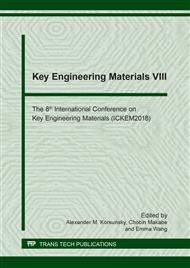[1]
Guide Body Armor, Selection & Application Guide 0101.06 to Ballistic-Resistant Body Armor. National Institute of Justice, (2014).
Google Scholar
[2]
E. Lewis and D. J. Carr, Personal armor, in: Lightweight Ballistic Composites (Second Edition), A. Bhatnagar (Eds). Woodhead Publishing, 2016, p.217–229.
DOI: 10.1016/b978-0-08-100406-7.00007-6
Google Scholar
[3]
Selection and Application Guide to Police Body Armor NIJ Guide 100-98. The National Institute of Justice's National Law Enforcement and Corrections Technology Center, (1998).
Google Scholar
[4]
M. Cheng, W. Chen, and T. Weerasooriya, Mechanical Properties of Kevlar® KM2 Single Fiber, J. Eng. Mater. Technol. 127 (2005), 197–203.
DOI: 10.1115/1.1857937
Google Scholar
[5]
H. Abdulghaffar, Study on the Arrangement of Fabric Materials for Multi-Layer Soft Body Armor Based on their Mechanical Properties, J. Fash. Technol. Text. Eng. 2015(2016).
DOI: 10.4172/2329-9568.1000126
Google Scholar
[6]
J. E. Jenkins, M. S. Creager, R. V. Lewis, G. P. Holland, and J. L. Yarger, Quantitative Correlation between the Protein Primary Sequences and Secondary Structures in Spider Dragline Silks, Biomacromolecules. 11(2010), 192–200.
DOI: 10.1021/bm9010672
Google Scholar
[7]
K. Murugesh Babu, Silk from silkworms and spiders as high-performance fibers, in: Structure and Properties of High-Performance Fibers, G. Bhat (Eds). Oxford: Woodhead Publishing, 2017, p.327–366.
DOI: 10.1016/b978-0-08-100550-7.00013-9
Google Scholar
[8]
A. Lin et al., Advances in understanding the properties of spider silk, in: Advances in Silk Science and Technology, A. Basu (Eds). Woodhead Publishing, 2015, p.17–40.
DOI: 10.1016/b978-1-78242-311-9.00002-1
Google Scholar
[9]
B. Wang, W. Yang, J. McKittrick, and M. A. Meyers, Keratin: Structure, mechanical properties, occurrence in biological organisms, and efforts at bioinspiration, Prog. Mater. Sci. 76 (2016), 229–318.
DOI: 10.1016/j.pmatsci.2015.06.001
Google Scholar
[10]
Y. Yu, W. Yang, B. Wang, and M. A. Meyers, Structure and mechanical behavior of human hair, Mater. Sci. Eng. C. 73 (2017), p.152–163.
Google Scholar
[11]
Kevlar® Aramid Fiber Technical Guide.
Google Scholar
[12]
J. A. Hall, Information Technology Auditing. Cengage Learning, (2010).
Google Scholar
[13]
P. M. Heathcote, A, Level Computing. Payne Gallway, (2005).
Google Scholar


